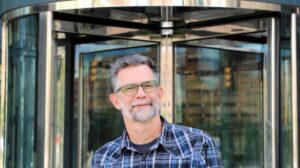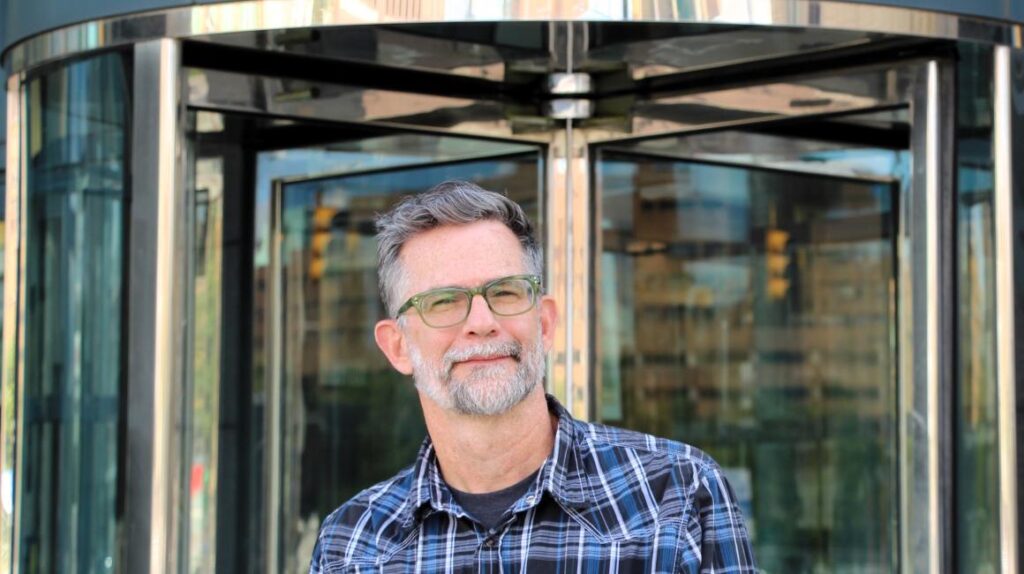Source: Michigan News

Paul Draus, faculty director of the U-M Detroit Center. Photo by Shaylynn Jones.

Paul Draus, faculty director of the U-M Detroit Center. Photo by Shaylynn Jones.
The University of Michigan Detroit Center hosts more events now than at any time since the pandemic began, and its new faculty director, Paul Draus, can take credit for a lot of that renewed energy.
Draus, a sociology professor at UM-Dearborn, joined the center in late June. He has taught at the Dearborn campus since 2005, and has been involved with numerous community-based research projects in Detroit. His most recent research projects brought him to Detroit’s alleys where he worked with neighborhood partners to bring these neglected areas into productive use.
Draus said his goals for the Detroit Center include building community engagement, boosting research initiatives and growing the university’s relationship with the metro area.
You’ve worn a number of hats at UM-Dearborn over the years. You directed the Master of Public Administration and the Master of Public Policy programs there, the criminology and criminal justice programs plus sociology and health policy studies. How have those experiences informed your role as faculty director of the Detroit Center?
Well, a number of ways I suppose. I was doing a lot of work related to public policy in Detroit, especially around issues of substance use and recovery, so we were doing a lot of collaborative research with public agencies, nonprofits and so on. I had a diverse background in terms of working for the government in the past, working in public health.
The fact was, and this is similar to the Detroit Center, there are a lot of people that know more than I do that are already doing work, so part of what I was doing was just trying to learn what they’re doing and trying to build off of it.
Coming to the Detroit Center, it’s natural for me to try to take a similar type of approach. What’s the Detroit Center already doing?
Every time I hear about something new, I try to ask more because now I have the license to be nosy. That’s a characteristic of sociologists anyway. We want to ask questions. We want to know, what are you doing in that community? What are the results of that study going to be? Who is going to benefit from that? How can we help you with that at the Detroit Center?
Learning more, getting to dive into that landscape more, and having the opportunity to help foster those connections, that to me becomes kind of the overarching goal to make those things—not to make them happen, but to foster more mutually beneficial collaborations and to do more with the ones that we already have, connecting dots and so on.
The Detroit Center is a physical space. We can host things. Obviously, we can offer the space for people to do their own programs and workshops and their own research projects, but we can also use the space to try to make more things happen in terms of conversation and collaboration. Make it like a two-way street where we’re going into Detroit communities saying who we are and what it is that we have to offer, but then we’re also bringing people into our space because we have a lot to learn from them.
What are some things you’d like to focus on initially?
Right now, we have a few things that are on the agenda. One is developing an Orientation Detroit program. This is something that Feodies (Shipp, Detroit Center director) has actually been thinking about for awhile, and we are taking steps to make that happen.
Basically, it’s going to be a three- or four-part series of recorded presentations for faculty who want to learn more about Detroit and do work in Detroit. One would be focused on the history of Detroit with Jamon Jordan, who is the historian for the city of Detroit and teaches in our Semester in Detroit program, one focused on data with Data Driven Detroit, something on the economy of Detroit and one with community-based organizations.
We still have our usual events, but we’re thinking about ways that we can amplify or improve some of those events. For example, we did the Concert of Colors in August. We’ve got the Thanksgiving Day Parade and Noel Night. Then, we’re looking at starting up a Detroit Community of Practice, which is kind of an invitation for all people at U-M that are doing work in Detroit.
You’ve also talked about bringing students back to the Detroit Center and Detroit. How might that look?
I think the pandemic obviously changed a lot of things, set a lot of things back, so in some ways this is kind of like an end and a beginning for the Detroit Center. It’s hopefully the end of that transition period, and now the beginning of this new period of growth and innovation.
To me, that’s kind of the idea, these ripples in a pond. Detroit is a big city, but it’s also a small city in a lot of ways. A lot of these ripples do intersect at some point or eventually, and so by us being at the center or being at the Detroit Center, we want to try to be at the center of those ripples and sending those ripples out, not just be like an event center.
When you were considering this role, what were you envisioning the center could be?
Well, I’ve thought about it over the years, because I’ve been using the Detroit Center since it opened pretty much. I started the same year, in 2005, when the Detroit Center officially opened. I did my first event there within a year or two. I’ve held classes, done faculty retreats and hosted workshops there.
I’ve been a user of the space, but I always had the question about its best use. I mean it is a space that we can use. It’s a nice space. It’s professional. It’s clean. It has equipment and stuff to use, but what does it actually represent in terms of U-M’s involvement in the city? How many people know about it?
I’ve always had the vision of kind of like a storefront. Having more of an open face to the street where you’re inviting people in so they can see what’s happening on the inside, and then you can learn about what’s happening on the outside.
That’s kinda the way I’m trying to see it. How is it outward-facing and reaching out into the community and inviting Detroit in? Also, how is it helping more people from U-M out into the community? Not just coming to the center, parking in the parking structure, doing an event there and leaving, but how does it get more people out into neighborhoods of Detroit or into different sites where things are happening?


